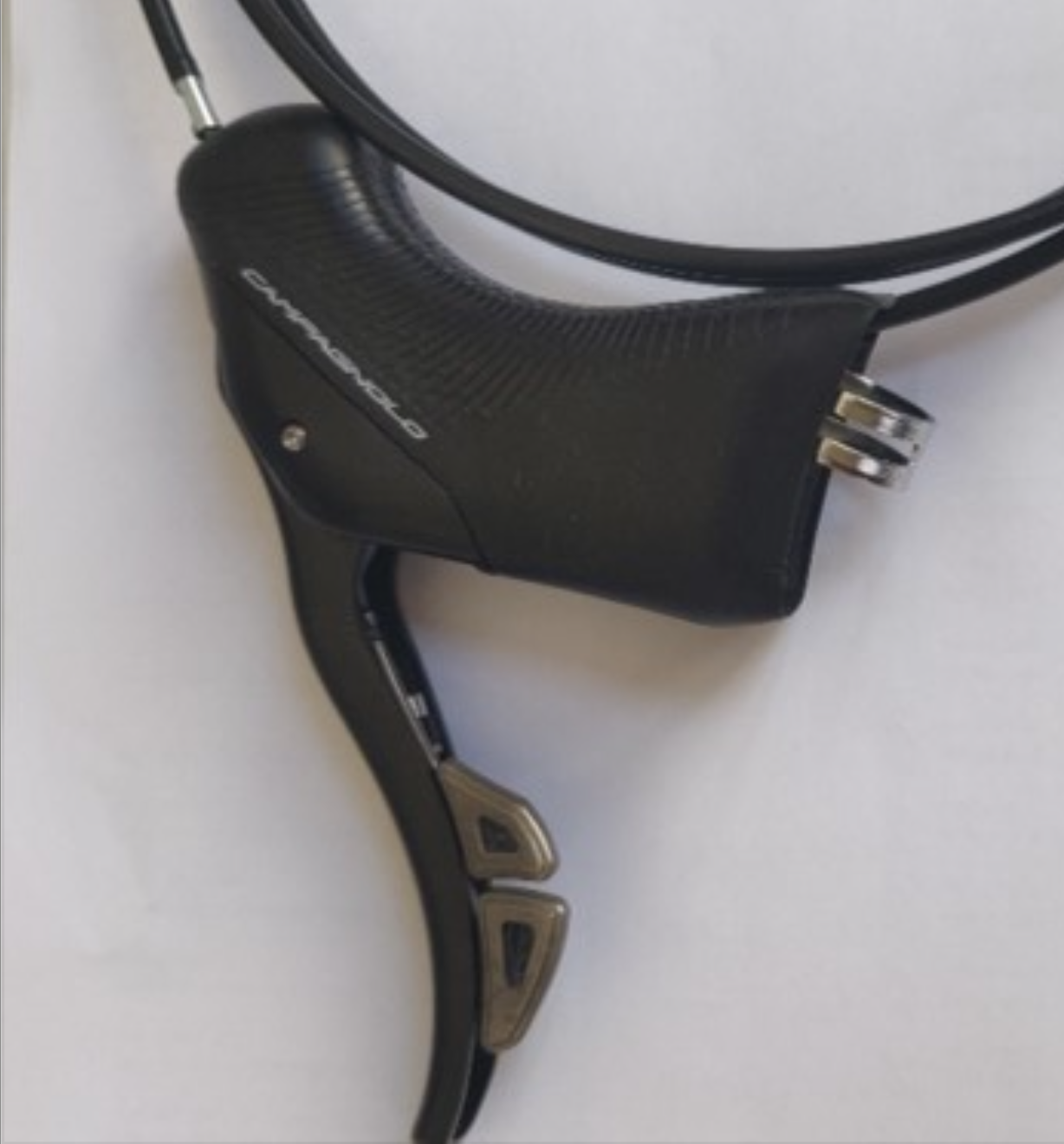No one from Vicenza is talking, but the rumors have been flying: is Campagnolo finally introducing wireless shifting? SRAM, of course, got things started with their fully wireless eTap system, introduced in 2015. In 2021, Shimano went semi-wireless (no shift-lever wires, but derailleurs connected to a central battery) with their latest generation of components, which now spans the range from Dura-Ace down to 105. Then there’s Classified: an entirely different approach to shifting, with a wirelessly controlled, two-speed internally gear hub. Everyone expects Campy will arrive to the wireless party too, if stylishly late.
Nothing beyond Campy’s current wired EPS system has yet been spotted on bikes, but patent and regulatory applications can give a sneak peek of coming technology. About two years ago, I took a deep dive into Campy’s patent filings to-date , looking at what they have disclosed and are trying to protect for wireless derailleurs and shift levers. That spanned about 10 patent applications – most as published in 2018 and 2019 – but for years after, nothing else surfaced from the company, either in patents or products.
Until now. Recently published US patent applications from Campagnolo are all about electronic shifting and wireless technology. In 2023, five of Campy’s US patent applications have published that relate to wireless shift levers, and five more for derailleurs and batteries. All indications point towards a fully wireless system, with batteries mounted inside shift levers and to each derailleur. Campagnolo did not immediately respond to an e-mail request for comment, but here’s what the legal documents tell us (keep in mind that drawings seen in patent applications need to support the claims of the invention, but a finished product may look quite different.)
The end of thumb lever shifting
Campagnolo introduced its mechanical Ergopower brake/shift levers over 30 years ago, and they’ve remained loyal to a thumb lever on the inside of the hood for downshifts – even their decade-old EPS wired electronic shifting carried on with a thumb lever, more out of tradition than necessity. But the latest patent filings show two “control levers” on the inside of the brake lever blade.
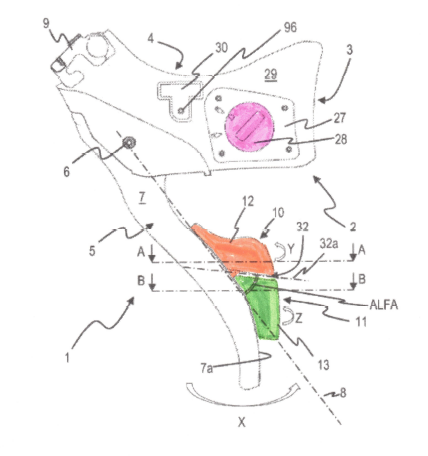
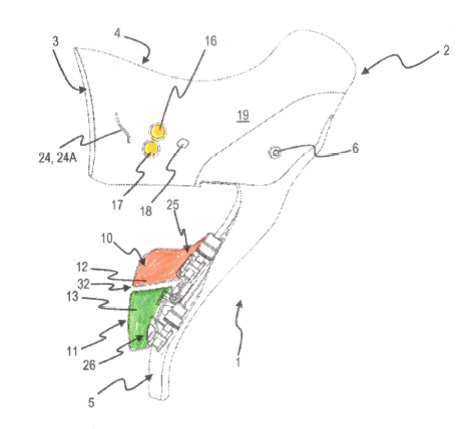
As shown in the patent drawings below, there’s an upper lever (12, in orange) for upshifts, the lower (13, in green) for downshifts. But your thumbs can still get in on the action, as two buttons (16 and 17, in yellow) on the inside of the lever body also provide shift capability. Again, upper for upshifts, lower for downshifts. Easy enough to remember in a field sprint, hopefully.
A cover (ref# 28, in pink) holds a coin-cell battery inside the lever. This provides power to a wireless communication module housed inside the lever. The wireless module includes an antenna, which has the option of being extended by a small coaxial cable inside the lever, to lessen the chances of a rider’s hand blocking the wireless signal.
The levers described appear to be strictly hydraulic for brake actuation, with details of a hydraulic tank and related workings, but no inclusion of alternate embodiments with a traditional Bowden-type cable.
When it introduced Dura-Ace 9200 in 2021, Shimano took the existing 9100 Di2 levers and modified them to accept the new EW-SD300 shift wires. The result was a mashup of sorts: a wired 12-speed electronic drivetrain with traditional rim-brake calipers. But Shimano has only produced those parts in extremely limited numbers and primarily for its pro team partners – who as of the 2022 season have almost entirely stopped using rim-brake bikes.
Campagnolo currently sponsors just one WorldTour team (Ag2r-la Mondiale), and the team’s bike sponsor, BMC, only makes a single rim-brake bike, a lower-tier version of its Timemachine TT bike than the team rides, meaning there won’t be any push for rim brake options from the team. If Campy drops rim brakes from its electronic groupsets, that leaves SRAM’s Red and Force eTap AXS groups as the last “new” drivetrain options to pair electronic shifting and rim brakes, and the only wireless ones. Both are compatible with 12- and 11-speed gearing.
Separate batteries for derailleurs
Several patent applications describe and show front and rear derailleurs with integrated batteries. One patent filing focuses primarily on mechanical design of such removable power supplies, rather than on particulars of electronic receiving and processing components. Drawings show a front derailleur with a removable battery that mounts to the front portion of the derailleur. That might help with tire clearance at the front derailleur, which has been a noted sore spot of Campagnolo’s current, wired EPS system.
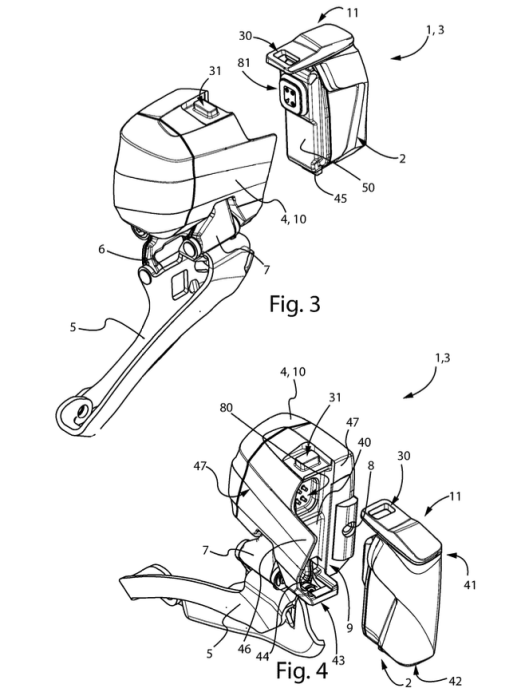
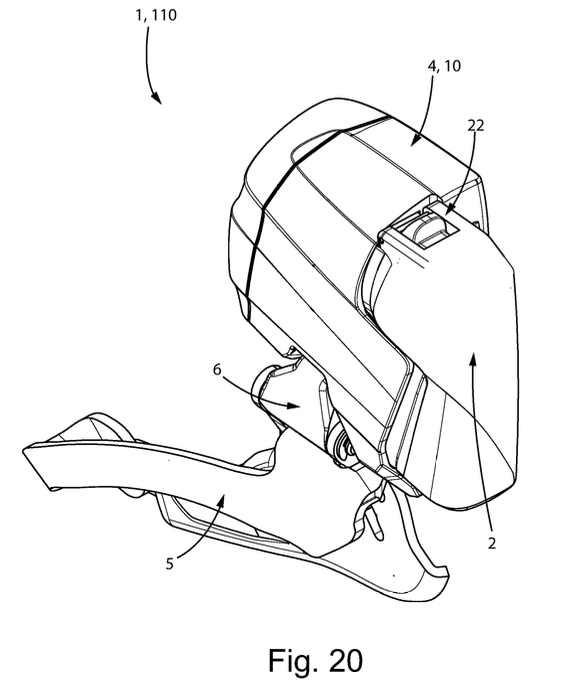
In this patent filing, the same battery fits both front and rear derailleurs. There’s nothing unusual looking about the rear derailleur with a direct-mount link shown, as Campy currently uses.
They’ve filed patent applications for two distinctly different types of mechanisms to secure the battery in place. One style (as above, and Fig 1 below) uses a hinged latch that locks the battery into place. That may seem familiar to eTap users, although it’s not necessarily an intellectual property issue. The other (Fig 20) uses a spring-loaded tab that slides, with that mechanism the primary focus of an entire patent application.
The patent filings include some specifics about gears and electronics and other fiddly internal bits. “The derailleur may also include a data processing system, controlling the geared motor and any other electric/electronic components of the derailleur.” Prior patent applications covered much of that underlying technology, so this latest info suggests refinement and detail towards making a finished product work.
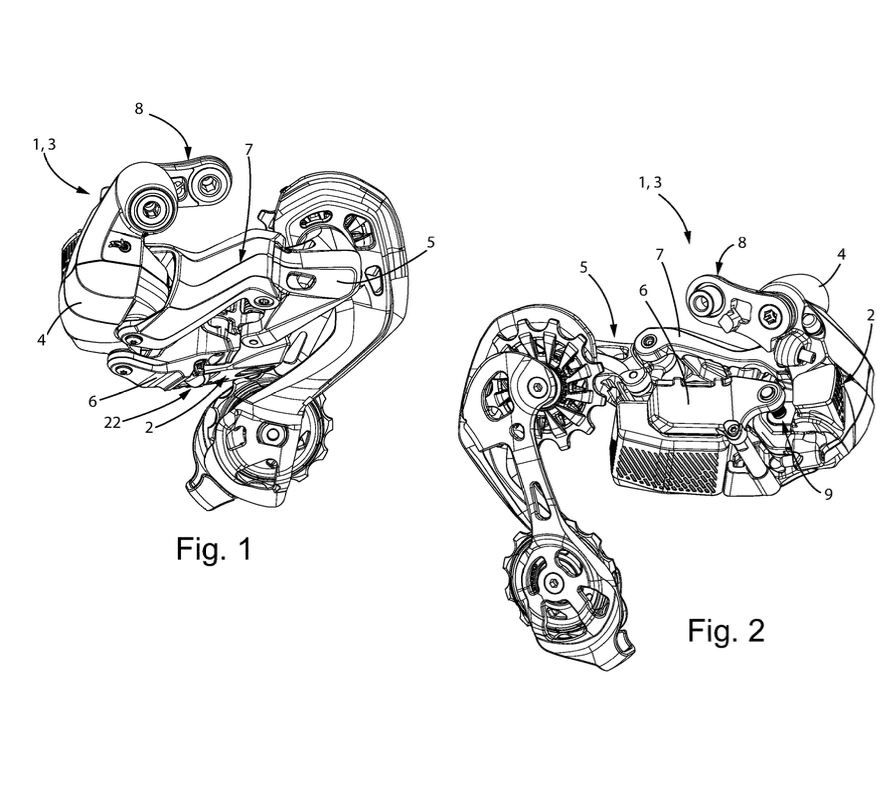
Where else might Campagnolo venture?
Being a patent application, Campy tries to cover all their bases by listing other components that their battery pack could power. Specifically: “… a suspension, a saddle setting adjuster, a lighting system, a satellite navigator, a training device, an anti-theft device, a cycle computer capable of providing information on the status of the bicycle, of the cyclist and/or of the route, a torque or power meter, a motor of a pedal assisted bicycle, a manual control device of another equipment, and others.”
I can imagine Campagnolo with their own power meters – they’ve partnered with SRM in the past, but have also have patent filings for crank-based torque and power sensing. With computers, there once was Ergobrain. And they show at least one e-bike patent application. Dropper posts? Lights? Suspension? Hard to fathom. Likely, such inclusions are simply for patent disclosure purposes, rather than a hint of what’s in the pipeline.
When is it coming? That’s impossible to say, but it may not be long. In the United States, any wireless communication protocol requires an FCC license, and a search of agency records does show regulatory approval. But perhaps more significantly, those records are accompanied by images of actual levers with features that largely match what’s in the patent applications, and finished-looking hoods with elements like texture patterns. That notably shows the electronics are fully developed, and the next step may be testing prototype drivetrains on Ag2r team bikes. Where SRAM cleverly hid eTap’s wireless capability with dummy wires, the new button layout on the Campy shifters would be a dead giveaway. Whether that happens this season or further out remains to be seen. I’ll continue monitoring patent applications, and Escape will keep eyes on pro team bikes for any new products.
Alan Coté is a Registered Patent Agent. He has been a contributing writer to various cycling publications over the past three decades, and is a former elite-level racer. This is his first article for Escape Collective.
What did you think of this story?
